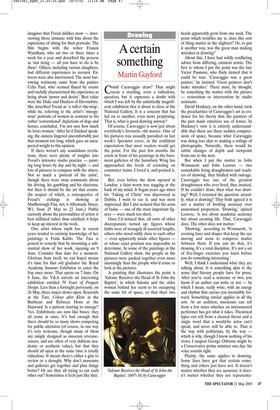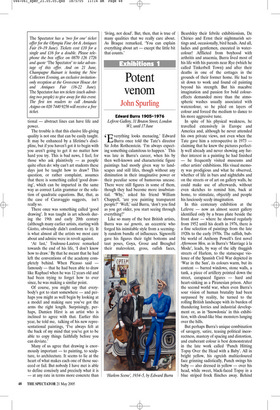A certain something
Martin Gayford
Could Caravaggio draw? That might seem a startling, even a ridiculous, question, but it expresses a doubt with which I was left by the admittedly magnificent exhibition that is about to close at the National Gallery. It is a concern that has led on to another, even more perplexing. That is, what is good drawing anyway?
Of course, Caravaggio is now just about everybody’s favourite old master. One of his pictures was casually parodied on last week’s Spectator cover, in the confident expectation that most readers would get the point. For the past few months the crush in front of his paintings in the basement galleries of the Sainsbury Wing has approached the levels of crowding on commuter trains. I loved it, and praised it, too.
But, even before the show opened in London, a faint worry was nagging at the back of my mind. It began years ago when his ‘Taking of Christ’ was discovered in Dublin. I went to see it, and was most impressed. But I also noticed that the arms of Judas — one of the most important figures — were much too short.
Once I’d noticed that, all sorts of other discrepancies turned up: figures whose limbs were of strangely ill-assorted lengths, others who stood oddly close to each other — even apparently inside other figures or whose exact position was impossible to determine. In some of the paintings in the National Gallery show, the people in the pictures were packed together even more alarmingly than the people who’d come to look at the pictures.
A painting that illustrates the point is ‘Salome Receives the Head of St John the Baptist’, in which Salome and the older woman behind her seem to be occupying the same bit of space, so that their two heads apparently grow from one neck. The point which troubles me is, does this sort of thing matter in the slightest? Or, to put it another way, was the great man making mistakes in drawing?
About this, I have had wildly conflicting advice from differing, eminent artists. The first to whom I put the point was the late Victor Pasmore, who flatly denied that it could be true. ‘Caravaggio was a great painter,’ he insisted. ‘Great painters don’t make mistakes.’ There must, he thought, be something the matter with the picture — restoration or intervention by studio assistants.
David Hockney, on the other hand, took the peculiarities of Caravaggio’s art as evidence for his theory that the painters of the past made extensive use of lenses. In Hockney’s view it is entirely understandable that there are these sudden compressions of space, because what Caravaggio was doing was akin to making a collage of photographs. Naturally, there would be subtle changes of depth and viewpoint from one to the next.
But when I put the matter to John Wonnacott and John Lessore — two remarkable living draughtsmen and teachers of drawing, they bridled with outrage. Caravaggio was one of the greatest draughtsmen who ever lived, they insisted. If he couldn’t draw, then what was drawing? Well, I returned the question: actually, what is drawing? They both agreed it is not a matter of footling accuracy over anatomical proportion. ‘Drawing,’ opined Lessore, ‘is not about academic accuracy but about creating life. That, Caravaggio does. The other does not matter.’ ‘Drawing,’ according to Wonnacott, ‘is creating lines and shapes that keep the eye moving and seem to compress matter between them. If you can do that, it’s drawing. It’s a total discipline. It’s not a set of five-finger exercises you learn before you do something interesting.’ Well, I think I understand what they are talking about. It is something akin to the sense that literary people have for prose. After you’ve read a sentence or two, you know if an author can write or not — by which I mean, really write, with an energy and rhythm that carries you irresistibly forward. Something similar applies in all the arts. At an audition, musicians can tell from a few notes whether an instrumental performer has got what it takes. Theatrical types can tell from a cleared throat and a single word that a would-be actor can’t speak, and never will be able to. That is the way with politicians, by the way which is why, though I know nothing of his views, I suspect George Osborne might be a Conservative prime minister one day: his voice sounds right.
Plainly, the same applies to drawing. Some lines have got that certain something and others just have not. It doesn’t matter whether they are accurate; it doesn’t matter whether they are representa The Spectator has a ‘two for one’ ticket offer for the Olympia Fine Art & Antiques Fair (9–19 June). Tickets cost £10 for a single and £16 for a double. Please telephone the box office on 0870 126 1726 and quote ‘The Spectator’ to take advantage of this offer. And on 21 June, Champagne Ruinart is hosting the New Collectors Evening, an exclusive invitationonly reception at the Grosvenor House Art and Antiques Fair (16-22 June). The Spectator has ten tickets (each admitting two people) to give away for this event. The first ten readers to call Amanda Asigno on 020 7440 9256 will receive a free ticket.
tional — abstract lines can have life and power.
The trouble is that this elusive life-giving quality is not one that can be easily taught. It may be enhanced by a lifetime’s discipline, but if you haven’t got it to begin with you aren’t going to get it no matter how hard you try. This is bad news, I feel, for those who ask plaintively — as people quite often do: why can’t art students these days just be taught how to draw? This question, or rather complaint, assumes that there is something called ‘good drawing’, which can be imparted in the same way as correct Latin grammar or the solution of quadratic equations. But, that, as the case of Caravaggio suggests, isn’t really so.
There once was something called ‘good drawing’. It was taught in art schools during the 19th and early 20th century (although many earlier artists, starting with Giotto, obviously didn’t conform to it). It is what almost all the artists we most care about and admire were in revolt against.
‘At last,’ Toulouse-Lautrec remarked towards the end of his life, ‘I don’t know how to draw.’ By that he meant that he had left the conventions of the academy completely behind. When Picasso said famously — that he had been able to draw like Raphael when he was 12 years old and had been trying to forget how to ever since, he was making a similar point.
Of course, you might say that everybody’s got to start somewhere — and perhaps you might as well begin by looking at a model and making sure you’ve got the arms the right length. Surprisingly, perhaps, Damien Hirst is an artist who is inclined to agree with that. Earlier this year, he told me, talking of his new representational paintings, ‘I’ve always felt at the back of my mind that you’ve got to be able to copy things faithfully before you can deviate.’ Many of us agree that drawing is enormously important — to painting, to sculpture, to architecture. It seems to lie at the heart of what makes each one of those succeed or fail. But nobody I have met is able to define concisely and precisely what it is — at any rate in terms more concrete than ‘living, not dead’. But, then, that is true of many qualities that we really care about. As Braque remarked, ‘You can explain everything about art — except the little bit that counts.’


























































 Previous page
Previous page